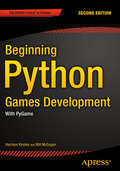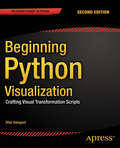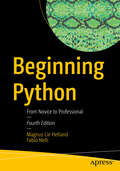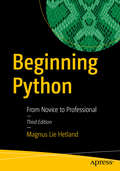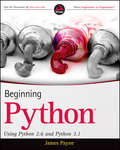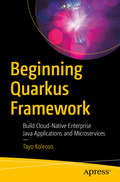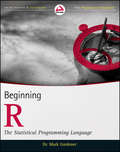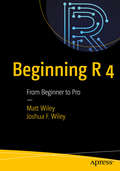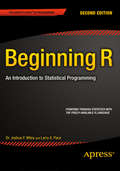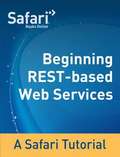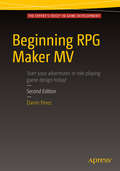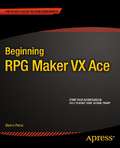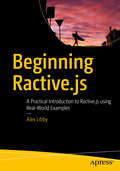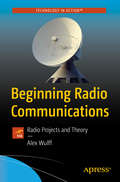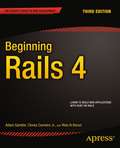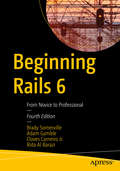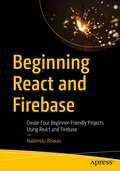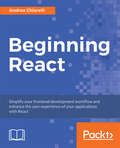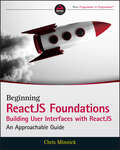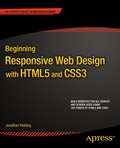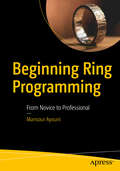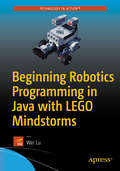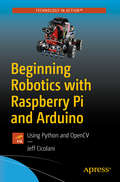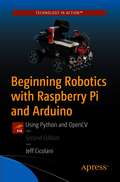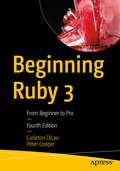- Table View
- List View
Beginning Python Games Development: With PyGame (Novice To Pro Ser.)
by Harrison Kinsley Will McguganLearn how to create compelling games using Python and the PyGame games development library. Beginning Python Games Development, Second Edition will teach you how to create visuals, do event handling, create 3D games, add media elements, and integrate OpenGL into your Python game. In this update to the first ever book to cover the popular open source PyGame games development library, you'll stand to gain valuable technical insights and follow along with the creation of a real-world, freely downloadable video game. Written by industry veterans and Python experts Will McGugan and Harrison Kinsley, this is a comprehensive, practical introduction to games development in Python. You can also capitalize upon numerous tips and tricks the authors have accumulated over their careers creating games for some of the world's largest game developers. What you'll learn How to use PyGame with Python for game development How to create visuals; do event handling; and more How to do 3D game development using Python How to add media elements How to create visually dynamic backgrounds by integrating some OpenGL and more into your Python-based game How to build a game project step by step Who this book is for This book is for Python coders wanting to learn how to build their first games. Game developers who may be new to Python and PyGame can use this book; a Python primer is included. Table of Contents 1. Introducing Python 2. Exploring Python 3. Introducing Pygame 4. Creating Visuals 5. Making Things Move 6. Accepting User Input 7. Take Me to Your Leader 8. Moving into the Third Dimension 9. Exploring the Third Dimension 10. Making Things Go Boom 11. Lights, Camera, Action! 12. Setting the Scene with OpenGL Appendix A: Game Object Reference Appendix B: Packaging Your Game
Beginning Python Visualization: Crafting Visual Transformation Scripts
by Shai VaingastWe are visual animals. But before we can see the world in its true splendor, our brains, just like our computers, have to sort and organize raw data, and then transform that data to produce new images of the world. Beginning Python Visualization: Crafting Visual Transformation Scripts, Second Edition discusses turning many types of data sources, big and small, into useful visual data. And, you will learn Python as part of the bargain. In this second edition you'll learn about Spyder, which is a Python IDE with MATLAB(R) -like features. Here and throughout the book, you'll get detailed exposure to the growing IPython project for interactive visualization. In addition, you'll learn about the changes in NumPy and Scipy that have occurred since the first edition. Along the way, you'll get many pointers and a few visual examples. As part of this update, you'll learn about matplotlib in detail; this includes creating 3D graphs and using the basemap package that allows you to render geographical maps. Finally, you'll learn about image processing, annotating, and filtering, as well as how to make movies using Python. This includes learning how to edit/open video files and how to create your own movie, all with Python scripts. Today's big data and computational scientists, financial analysts/engineers and web developers - like you - will find this updated book very relevant.
Beginning Python: From Novice to Professional
by Magnus Lie Hetland Fabio NelliGain a fundamental understanding of Python’s syntax and features with this revised introductory and practical reference. Covering a wide array of Python–related programming topics, including addressing language internals, database integration, network programming, and web services, you’ll be guided by sound development principles. Updated to reflect the latest in Python programming paradigms and several of the most crucial features found in Python 3, Beginning Python, Fourth Edition also covers advanced topics such as extending Python and packaging/distributing Python applications. Ten accompanying projects will ensure you can get your hands dirty in no time. You will: Become a proficient Python programmer by following along with a friendly, practical guide to the language’s key features Write code faster by learning how to take advantage of advanced features such as magic methods, exceptions, and abstraction Gain insight into modern Python programming paradigms including testing, documentation, packaging, and distribution Work through several interesting projects, including a P2P file–sharing application, chat client, video game, remote text editor, and more Who This Book Is For Programmers, novice and otherwise, seeking a comprehensive introduction to the Python programming language.
Beginning Python: From Novice to Professional (Novice To Pro Ser.)
by Magnus Lie HetlandGain a fundamental understanding of Python's syntax and features with the second edition of Beginning Python, an up-to-date introduction and practical reference. Covering a wide array of Python-related programming topics, including addressing language internals, database integration, network programming, and web services, you'll be guided by sound development principles. Ten accompanying projects will ensure you can get your hands dirty in no time. Updated to reflect the latest in Python programming paradigms and several of the most crucial features found in Python 3. 0 (otherwise known as Python 3000), advanced topics, such as extending Python and packaging/distributing Python applications, are also covered. What you'll learn Become a proficient Python programmer by following along with a friendly, practical guide to the language's key features Write code faster by learning how to take advantage of advanced features such as magic methods, exceptions, and abstraction Gain insight into modern Python programming paradigms including testing, documentation, packaging, and distribution Learn by following along with ten interesting projects, including a P2P file-sharing application, chat client, video game, remote text editor, and more Complete, downloadable code is provided for each project! Who this book is for Programmers, novice and otherwise, seeking a comprehensive introduction to the Python programming language.
Beginning Python®
by James PayneBeginning Python: Using Python 2. 6 and Python 3. 1 introduces this open source, portable, interpreted, object-oriented programming language that combines remarkable power with clear syntax. This book enables you to quickly create robust, reliable, and reusable Python applications by teaching the basics so you can quickly develop Web and scientific applications, incorporate databases, and master systems tasks on various operating systems, including Linux, MAC OS, and Windows. You'll get a comprehensive tutorial that guides you from writing simple, basic Python scripts all the way through complex concepts, and also features a reference of the standard modules with examples illustrating how to implement features in the various modules. Plus, the book covers using Python in specific program development domains, such as XML, databases, scientific applications, network programming, and Web development. Note: CD-ROM/DVD and other supplementary materials are not included as part of eBook file.
Beginning Quarkus Framework: Build Cloud-Native Enterprise Java Applications and Microservices
by Tayo KoleosoHarness the power of Quarkus, the supersonic subatomic cloud-native Java platform from Red Hat. This book covers everything you need to know to get started with the platform, which has been engineered from the ground up for superior performance and cloud-native deployment. You’ll start with an overview of the Quarkus framework and its features. Next, you'll dive into building your first microservice using Quarkus, including the use of JAX-RS, Swagger, Microprofile, REST, reactive programming, and more. You’ll see how to seamlessly add Quarkus to existing Spring framework projects. The book continues with a dive into the dependency injection pattern and how Quarkus supports it, working with annotations and facilities from both Jakarta EE CDI and the Spring framework. You’ll also learn about dockerization and serverless technologies to deploy your microservice. Next you’ll cover how data access works in Quarkus with Hibernate, JPA, Spring Boot, MongoDB, and more. This will also give you an eye for efficiency with reactive SQL, microservices, and many more reactive components. You’ll also see tips and tricks not available in the official documentation for Quarkus. Lastly, you'll test and secure Quarkus-based code and use different deployment scenarios to package and deploy your Quarkus-based microservice for the cloud, using Amazon Web Services as a focus. After reading and using Beginning Quarkus Framework, you'll have the essentials to build and deploy cloud-native microservices and full-fledged applications. Author Tayo Koleoso goes to great lengths to ensure this book has up to date material including brand new and some unreleased features! What You Will Learn Build and deploy cloud-native Java applications with Quarkus Create Java-based microservices Integrate existing technologies such as the Spring framework and vanilla Java EE into the Quarkus framework Work with the Quarkus data layer on persistence with SQL, reactive SQL, and NoSQL Test code in Quarkus with the latest versions of JUnit and Testcontainers Secure your microservices with JWT and other technologies Package your microservices with Docker containers and GraalVM native image toolingTips and techniques you won't find in the official Quarkus documentation Who This Book Is For Intermediate Java developers familiar with microservices, the cloud in general, and REST web services, but interested in modern approaches.
Beginning R
by Mark GardenerConquer the complexities of this open source statistical languageR is fast becoming the de facto standard for statistical computing and analysis in science, business, engineering, and related fields. This book examines this complex language using simple statistical examples, showing how R operates in a user-friendly context. Both students and workers in fields that require extensive statistical analysis will find this book helpful as they learn to use R for simple summary statistics, hypothesis testing, creating graphs, regression, and much more. It covers formula notation, complex statistics, manipulating data and extracting components, and rudimentary programming.R, the open source statistical language increasingly used to handle statistics and produces publication-quality graphs, is notoriously complex This book makes R easier to understand through the use of simple statistical examples, teaching the necessary elements in the context in which R is actually usedCovers getting started with R and using it for simple summary statistics, hypothesis testing, and graphsShows how to use R for formula notation, complex statistics, manipulating data, extracting components, and regressionProvides beginning programming instruction for those who want to write their own scriptsBeginning R offers anyone who needs to perform statistical analysis the information necessary to use R with confidence.
Beginning R 4: From Beginner to Pro
by Joshua F. Wiley Matt WileyLearn how to use R 4, write and save R scripts, read in and write out data files, use built-in functions, and understand common statistical methods. This in-depth tutorial includes key R 4 features including a new color palette for charts, an enhanced reference counting system (useful for big data), and new data import settings for text (as well as the statistical methods to model text-based, categorical data). Each chapter starts with a list of learning outcomes and concludes with a summary of any R functions introduced in that chapter, along with exercises to test your new knowledge. The text opens with a hands-on installation of R and CRAN packages for both Windows and macOS. The bulk of the book is an introduction to statistical methods (non-proof-based, applied statistics) that relies heavily on R (and R visualizations) to understand, motivate, and conduct statistical tests and modeling.Beginning R 4 shows the use of R in specific cases such as ANOVA analysis, multiple and moderated regression, data visualization, hypothesis testing, and more. It takes a hands-on, example-based approach incorporating best practices with clear explanations of the statistics being done.You will:Acquire and install R and RStudioImport and export data from multiple file formatsAnalyze data and generate graphics (including confidence intervals)Interactively conduct hypothesis testingCode multiple and moderated regression solutions Who This Book Is For Programmers and data analysts who are new to R. Some prior experience in programming is recommended.
Beginning R: An Introduction to Statistical Programming
by Larry A. Pace Joshua F. WileyBeginning R, Second Edition is a hands-on book showing how to use the R language, write and save R scripts, read in data files, and write custom statistical functions as well as use built in functions. This book shows the use of R in specific cases such as one-way ANOVA analysis, linear and logistic regression, data visualization, parallel processing, bootstrapping, and more. It takes a hands-on, example-based approach incorporating best practices with clear explanations of the statistics being done. It has been completely re-written since the first edition to make use of the latest packages and features in R version 3. R is a powerful open-source language and programming environment for statistics and has become the de facto standard for doing, teaching, and learning computational statistics. R is both an object-oriented language and a functional language that is easy to learn, easy to use, and completely free. A large community of dedicated R users and programmers provides an excellent source of R code, functions, and data sets, with a constantly evolving ecosystem of packages providing new functionality for data analysis. R has also become popular in commercial use at companies such as Microsoft, Google, and Oracle. Your investment in learning R is sure to pay off in the long term as R continues to grow into the go to language for data analysis and research. What you'll learn How to acquire and install R Hot to import and export data and scripts How to analyze data and generate graphics How to program in R to write custom functions Hot to use R for interactive statistical explorations How to conduct bootstrapping and other advanced techniques Who this book is for Beginning R, Second Edition is an easy-to-read book that serves as an instruction manual and reference for working professionals, professors, and students who want to learn and use R for basic statistics. It is the perfect book for anyone needing a free, capable, and powerful tool for exploring statistics and automating their use. Table of Contents Part I. Learning the R Language 1. Getting Started 2. Dealing with Dates, Strings, and Data Frames 3. Input and Output 4. Control Structures Part II. Using R for Descriptive Statistics 5. Functional Programming 6. Probability Distributions 7. Working with Tables Part III. Using R for Inferential Statistics 8. Descriptive Statistics and Exploratory Data Analysis 9. Working with Graphics 10. Traditional Statistical Methods 11. Modern Statistical Methods 12. Analysis of Variance 13. Correlation and Regression 14. Multiple Regression 15. Logistic Regression 16. Modern Statistical Methods II Part IV. Taking R to the Next Level 17. Data Visualization Cookbook 18. High-performance Computing 19. Text Mining
Beginning RESTful Web Services: A Safari Tutorial
by Safari Content TeamThis is the first of a three-part series looking at how to build RESTful web services. The series covers all aspects of REST services, from basic HTTP-level interactions, through to matching these operations in your existing code and applications, network security, and adherence for REST standards. Over the years a number of different web-based service technologies have been developed, including XML-RPC, SOAP and REST. So called RESTful services are easy to use and consume from the client side, and have a much lighter overhead for communicating and exchanging information. From a server side perspective, they can be more difficult to implement and build because of the state-less nature of the service, while generally being easier to map to existing functions, methods and internal structures. Follow along in this tutorial to learn about the fundamentals of web services, how REST fits into the web services model, and the mechanics of REST services with Java in Safari Books Online.
Beginning RPG Maker MV
by Darrin PerezCreate your very own role playing game using the RPG Maker MV game development engine. You'll go through tutorials and exercises that will take you from installing the software to putting the final touches upon your first project. Beginning RPG Maker MV has been designed with the complete beginner in mind who has little to no experience with the engine. It includes full JavaScript code, replacing the old Ruby commands. Game design can be quite a daunting challenge, as it generally involves a large amount of programming know-how on top of having to plan everything out that makes a good game what it is. RPG Maker MV is an intuitive system that allows you to make your own game with a fraction of the effort otherwise required. Beginning RPG Maker MV equips you with the knowledge you need to use Enterbrain's newest role playing game development engine. Takes you from the start of a project to the completion of a small game. Provides a step-by-step process that will walk you through each stage of the creation process. Gives many helpful tips and tricks you can apply to your future endeavors with the engine. What you'll learn Use switches and variables to affect the game world Populate your areas with non-player characters that serve a wide range of roles Use the database which serves as the backbone of RPG Maker MV Create dungeons with two types of enemy encounter Create fun and varied mini-games and side-quests to serve as distractions from the main plot Write scripts using RPG Maker MV's Script Editor Who this book is for Beginning RPG Maker MV is for novices in game design who would like to learn how to use a simple, yet robust, game development engine. It's for those people who have little to no programming experience but would like to make an RPG.
Beginning RPG Maker VX Ace
by Darrin PerezBeginning RPG Maker VX Ace takes you through the process of using the RPG Maker VX Ace game development engine to create your very own role playing game. The book has been designed with the complete beginner in mind who has little to no experience with the engine. Tutorials and exercises will take you from installing the software to putting the final touches upon your first project. Game design can be quite a daunting challenge, as it generally involves a large amount of programming know-how on top of having to plan everything out that makes a good game what it is. RPG Maker VX Ace is an intuitive system that allows you to make your own game with a fraction of the effort otherwise required. Beginning RPG Maker VX Ace equips you with the knowledge you need to use Enterbrain's newest role playing game development engine. Takes you from the start of a project to the completion of a small game. Provides a step-by-step process that will walk you through each stage of the creation process. Gives many helpful tips and tricks you can apply to your future endeavors with the engine.
Beginning Ractive.js: A Practical Introduction to Ractive.js using Real-World Examples
by Alex LibbyDevelop websites using the Ractive. js template-driven UI library. This book is project-oriented and simplifies the process of using Ractive. js to create websites or online applications that are interactive by default. It equips you with a starting toolset to develop future projects, safe in the knowledge that the site operates as expected, and is not reliant on bloated technology, typical of other similar frameworks. Beginning Ractive. js takes the view that you shouldn't always resort to what "everyone else uses", and that there is indeed a different way you can achieve the same result. We live in an age where speed and simplicity are of the essence - this book provides a perfect alternative that challenges the norm. Stop thinking you must use the same library as everyone else. Give Ractive a try! What You'll Learn Understand how Ractive. js works and how it differs to other templating frameworks. templates="" that="" are="" interactive="" from="" the="" outset. Source and manage data using Ractive. js' data binding methods. Gain an appreciation of managing events and animations using Ractive. js. Create components that contain reusability functionality for current or future projects. Work through real-world project examples using the Ractive. js library. Who This Book is For Website developers who are keen to develop a fully interactive, template-driven website quickly, but don't have the desire to learn a more heavyweight framework, such as AngularJS. Agile development teams, where time is of the essence, and the pressure is on to deliver results quickly. Developers who want to focus on simplicity, where the library works for them, and they are not constrained by having to follow a particular methodology.
Beginning Radio Communications: Radio Projects and Theory
by Alex WulffUnderstanding radio communications systems unlocks a new way to look at the world and the radio waves that connect it. Through easy-to-understand instruction and a variety of hands-on projects, this book gives the reader an intuitive understanding of how radio waves propagate, how information is encoded in radio waves, and how radio communications networks are constructed. This book also focuses on the world of amateur, or “ham,” radio, a global network of hobbyists that experiment and communicate with radio waves. The reader can learn what amateur radio is, how one can obtain an amateur radio license, and how various pieces of amateur radio hardware work. Rather than overwhelm with formulas and numerical approaches, this book presents an easy-to-follow qualitative approach to the theory aspects of radio—perfect for those with little to no knowledge of electromagnetism, signal processing, or hardware development. Instead, instruction focuses on hands-on learning. Radio waves are easy and inexpensive to manipulate with modern hardware, so the examples throughout this text provide ample opportunity to develop an understanding of such hardware. A special focus is given to applications of radio communications in the modern world. In every chapter, the reader gains new insight into different radio communications systems and the hardware and software that makes it all possible. Projects include using a software-defined radio to download live images of the Earth from weather satellites, Arduino-based digital radio communications networks, making amateur radio contacts, and more.What You’ll Learn: · Encode information in radio waves · Obtain an amateur radio license · Use important pieces of radio communications hardware, such as antennas, handheld transceivers, software-defined radios, radio repeaters, and moreWho This Book Is ForAnyone interested in modern communications, from high school and college students pursuining STEM to professionals looking to broaden their understandings of radio
Beginning Rails 4
by Adam Gamble Cloves Carneiro Rida Al BaraziBeginning Rails 4 is a book that will guide you from never having programmed with Ruby, to having a Rails application built and deployed to the web. You'll learn how to combine all the components of Rails to develop your own web applications. You will use test driven development to make sure your application works exactly like you expect. You will learn how to use Git for source control and best practice techniques to create applications like a pro. Essential, and often-missed, information on testing and learning to program with Ruby are also covered. This book is well suited for someone with little to no Ruby or Rails experience, or possibly even someone with no experience developing web applications at all. Beginning Rails 4 does assume a basic familiarity with the web and typical web terms, but doesn't require you to be an expert of these. This book will springboard your journey into web application development, and show you how much fun building web applications with Ruby on Rails can be. Learn to create Rails applications from the bottom up Learn the basics of the Ruby programming language Completely updated for Rails 4, including new information on turbo links, etc. Beginning Rails 4 gently guides you through designing your application, writing tests for the application, and then writing the code to make your application work as expected. What you'll learn Learn the basics of the Ruby programming language Learn the components of Rails, and how to leverage them to build rich web applications Build a good foundation so you can move on to more advanced techniques Learn the basics of databases and how to use them to store and retrieve your data Use git source control and contribute to open source on Github Deploy your application to the web so others can use it Who this book is for Beginning Rails 4 is for anyone who wants to learn to quickly build applications, and deploy them to the web. No matter your experience level you'll learn something from this book. Table of Contents Introducing the Rails Framework Getting Started Getting Something Running Introduction to the Ruby Language Working with a Database: Active Record Advanced Active Record: Enhancing Your Models Action Pack: Working with the View and the Controller Advanced Action Pack JavaScript and CSS Sending and Receiving Email Testing Your Application Internationalization Deploying Your Rails Applications Appendix A: Databases 101 Appendix B: The Rails Community Appendix C: Git
Beginning Rails 6: From Novice to Professional
by Adam Gamble Cloves Carneiro Jr. Brady Somerville Rida Al BaraziSpringboard your journey into web application development and discover how much fun building web applications with Ruby on Rails can be. This book has been revised to cover what's new in Rails 6 including features such as WebPack, advanced JavaScript integration, Action Mailbox, Action Text, system and parallel testing, Action Cable testing, and more. Beginning Rails 6 gently guides you through designing your application, writing tests for the application, and then writing the code to make your application work as expected. It is a book that will guide you from never having programmed with Ruby, to having a Rails 6 application built and deployed to the web. After reading and using this book, you'll have the know-how and the freely available source code to get started with your own Rails-based web development in days. What You Will Learn Create Ruby on Rails 6 web applications from the bottom upGain the basics of the Ruby programming languageCombine all the components of Rails to develop your own web applications Apply TDD to make sure your application works exactly as you expect Use Git source control and best practice techniques to create applications like a pro Who This Book Is For Someone with little to no Ruby or Rails experience, or possibly even someone with no experience developing web applications at all. A basic familiarity with the web and typical web terms is assumed, but you don’t need to be an expert in these.
Beginning React and Firebase: Create Four Beginner-Friendly Projects Using React and Firebase
by Nabendu BiswasUse React with Firebase to build four beginner-friendly apps. A lot of React tutorials out there today only cover basic web apps, but with additional features the web apps included in this book can be converted into fully scaled startups. You will start with the basics: learn to deploy a React app with Firebase hosting. Next, you will learn to create a fully functional "ToDo" app that will use Firebase database to store a list action items. You will also learn to create a "Stories" app, in which you can show short vertical videos, and a document storage app. Here, we will be able to log in using Google Authentication, and will learn to store files in the app using Firebase storage. Lastly, you will create a career social media app. Your users will be able to log in using email and password authentication. You will learn to use Redux in this project.While creating these web apps, you will employ multiple concepts, including React hooks, React components, and how to use Material UI. You will learn to use Firebase to host your database, as well as hosting your app. With these projects in your portfolio you'll be ready to take your developer skills to the next level. What You'll Learn Use Firebase’s powerful services, and how to connect Firebase with ReactExplore the React ecosystem, including Redux and React hooksWork with MaterialUI, the popular React UI frameworkUnderstand how to use Google Authentication techniques in your sitesDeploy all sites using simple Firebase hosting Who This Book Is For Developers at the beginning of their career, or anyone who wants to take their React skills to the next level.
Beginning React: Simplify your frontend development workflow and enhance the user experience of your applications with React
by Andrea ChiarelliTake your web applications to a whole new level with efficient, component-based UIs that deliver cutting-edge interactivity and performance.Key FeaturesElaborately explains basics before introducing advanced topics Explains creating and managing the state of components across applicationsImplement over 15 practical activities and exercises across 11 topics to reinforce your learningBook DescriptionProjects like Angular and React are rapidly changing how development teams build and deploy web applications to production. In this book, you’ll learn the basics you need to get up and running with React and tackle real-world projects and challenges. It includes helpful guidance on how to consider key user requirements within the development process, and also shows you how to work with advanced concepts such as state management, data-binding, routing, and the popular component markup that is JSX. As you complete the included examples, you’ll find yourself well-equipped to move onto a real-world personal or professional frontend project.What you will learnUnderstand how React works within a wider application stackAnalyze how you can break down a standard interface into specific componentsSuccessfully create your own increasingly complex React components with HTML or JSXCorrectly handle multiple user events and their impact on overall application stateUnderstand the component lifecycle to optimize the UX of your applicationConfigure routing to allow effortless, intuitive navigation through your componentsWho this book is forIf you are a frontend developer who wants to create truly reactive user interfaces in JavaScript, then this is the book for you. For React, you’ll need a solid foundation in the essentials of the JavaScript language, including new OOP features that were introduced in ES2015. An understanding of HTML and CSS is assumed, and a basic knowledge of Node.js will be useful in the context of managing a development workflow, but is not essential.
Beginning ReactJS Foundations Building User Interfaces with ReactJS: An Approachable Guide
by Chris MinnickQuickly learn the most widely used front-end development language with ease and confidence React JS Foundations: Building User Interfaces with ReactJS - An Approachable Guide walks readers through the fundamental concepts of programming with the explosively popular front-end tool known as React JS. Written by an accomplished full-stack engineer, speaker, and community organizer, React JS Foundations teaches readers how to understand React and how to begin building applications with it. The book: Explains and clarifies technical terminology with relevant and modern examples to assist people new to programming understand the language Helps experienced programmers quickly get up to speed with React Is stocked throughout with practical and applicable examples of day-to-day React workPerfect for beginner, intermediate, and advanced programmers alike, React JS Foundations will quickly bring you up to speed on one of the most useful and widely used front-end languages on the web today. You can start building your first application today.
Beginning Responsive Web Design with HTML5 and CSS3
by Jonathan FieldingBeginning Responsive Web Design with HTML5 and CSS3 is your step-by-step guide to learning how to embrace responsive design for all devices. You will learn how to develop your existing HTML, CSS, and JavaScript skills to make your sites work for the modern world. Web sites and apps are now accessed on a wide range of devices with varied sizes and dimensions, so ensuring your users have the best experience now means thinking responsive. In Beginning Responsive Web Design with HTML5 and CSS3 you will learn about all aspects of responsive development. You'll start with media queries, and fluid CSS3 layouts. You'll see how to use responsive frameworks such as Twitter Bootstrap, and how to use tools such as Grunt, Bower, Sass, and LESS to help save you time. You'll also learn how to use JavaScript to manage responsive states, manage your user's journey across screen sizes, and optimize your responsive site. By the end of the book you will be able to build new sites responsively, and update existing sites to be responsive. Every aspect of a responsive build will be covered. This book is perfect for developers who are looking to move into the future of responsive sites. Whether you have already dipped your toes into responsive development or are just getting started, Beginning Responsive Web Design with HTML5 and CSS3 will teach you the very best techniques to optimize your site and your user's experience.
Beginning Ring Programming: From Novice to Professional
by Mansour AyouniGain a gentle introduction to the world of Ring programming with clarity as a first concern using a lot of practical examples. The first part lays the foundations of the language and its basic features (data types, control structures, functions, and classes). The unique way to rigorously structure Ring programs is also explained. Then, in the second part you’ll discover Ring inputs, outputs, and what is in between. You’ll use the basic constructs of computer logic (sequence, selection, and iteration) to build simple and complex logic flows. You’ll go over the common mistakes that lead to code complexity, by example, and cover several strategies to solve them (refactoring, code cleansing, and good variable naming). Then, you’ll see a visual illustration of how Ring deals with scopes at the local, object, and global levels. In part three, you’ll play with two artifacts vital to Ring programming: functions and objects. You’ll learn how they can be composed to solve a problem and how advanced programming paradigms, such as declarative and natural, are beautifully implemented on top of them. As part of the discussion, you’ll also work on game programming. You’ll learn how you design your game declaratively, in Ring code, just as if you were designing it in visual software. Finally, the author lays out how programming can be understood in a gamified context. You will be told the truth about how gaming can be a better metaphor to achieve mastery of Ring programming.This book is for those who are passionate about writing beautiful, expressive, and learnable code. It has been designed so you can enjoy a beginner-friendly set of knowledge about Ring, and benefit from a one-stop collection of lessons learned from real-world, customer-facing programming projects.What You Will LearnGet started with Ring and master its data types, I/O, functions, and classesCarry out structural, object-oriented, functional, declarative, natural, and meta programming in RingUse the full power of Ring to refactor program code and develop clean program architecturesQuickly design professional-grade video games on top of the Ring game engine Who This Book Is For Beginners looking for a consistent and hackable programming environment with a strong flavor of learnability and expressiveness.
Beginning Robotics Programming in Java with LEGO Mindstorms
by Wei LuDiscover the difference between making a robot move and making a robot think. Using Mindstorms EV3 and LeJOS--an open source project for Java Mindstorms projects--you'll learn how to create Artificial Intelligence (AI) for your bot. Your robot will learn how to problem solve, how to plan, and how to communicate. Along the way, you'll learn about classical AI algorithms for teaching hardware how to think; algorithms that you can then apply to your own robotic inspirations. If you've ever wanted to learn about robotic intelligence in a practical, playful way, Beginning Robotics Programming in Java with LEGO Mindstorms is for you. What you'll learn: Build your first LEGO EV3 robot step-by-step Install LeJOS and its firmware on Lego EV3 Create and upload your first Java program into Lego EV3 Work with Java programming for motors Understand robotics behavior programming with sensors Review common AI algorithms, such as DFS, BFS, and Dijkstra's Algorithm Who this book is for: Students, teachers, and makers with basic Java programming experience who want to learn how to apply Artificial Intelligence to a practical robotic system.
Beginning Robotics with Raspberry Pi and Arduino
by Jeff CicolaniLearn how to use a Raspberry Pi in conjunction with an Arduino to build a basic robot with advanced capabilities. Getting started in robotics does not have to be difficult. This book is an insightful and rewarding introduction to robotics and a catalyst for further directed study. You'll be led step by step through the process of building a robot that uses the power of a Linux based computer paired with the simplicity of Arduino. You’ll learn why the Raspberry Pi is a great choice for a robotics platform; its strengths as well as its shortcomings; how to overcome these limitations by implementing an Arduino; and the basics of the Python programming language as well as some of the more powerful features.With the Raspberry Pi you can give your project the power of a Linux computer, while Arduino makes interacting with sensors and motors very easy. These two boards are complimentary in their functions; where one falters the other performs admirably.The book also includes references to other great works to help further your growth in the exciting, and now accessible, field of smart robotics. As a bonus, the final chapter of the book demonstrates the real power of the Raspberry Pi by implementing a basic vision system. Using OpenCV and a standard USB web cam, you will build a robot that can chase a ball.What You'll LearnInstall Raspbian, the operating system that drives the Raspberry PiDrive motors through an I2C motor controllerRead data through sensors attached to an ArduinoWho This Book Is For Hobbyists and students looking for a rapid start in robotics. It assumes no technical background. Readers are guided to pursue the areas that interest them in more detail as they learn.
Beginning Robotics with Raspberry Pi and Arduino: Using Python and OpenCV
by Jeff CicolaniLearn how to use a Raspberry Pi in conjunction with an Arduino to build a basic robot with advanced capabilities. Getting started in robotics does not have to be difficult. This book is an insightful and rewarding introduction to robotics and a catalyst for further directed study. Fully updated to cover the Raspberry Pi 4 with its better processor and memory, discover new ways to work with Computer Vision. You'll be led step by step through the process of building a robot that uses the power of a Linux based computer paired with the simplicity of Arduino. You’ll learn why the Raspberry Pi is a great choice for a robotics platform; its strengths as well as its shortcomings; how to overcome these limitations by implementing an Arduino; and the basics of the Python programming language as well as some of the more powerful features.With the Raspberry Pi you can give your project the power of a Linux computer, while Arduino makes interacting with sensors and motors very easy. These two boards are complimentary in their functions; where one falters the other performs admirably.The book also includes references to other great works to help further your growth in the exciting, and now accessible, field of smart robotics. As a bonus, the final chapter of the book demonstrates the real power of the Raspberry Pi by implementing a basic vision system. Using OpenCV and a standard USB web cam, you will build a robot that can chase a ball.What You'll LearnInstall Raspbian, the operating system that drives the Raspberry PiDrive motors through an I2C motor controllerRead data through sensors attached to an ArduinoWho This Book Is For Hobbyists and students looking for a rapid start in robotics. It assumes no technical background. Readers are guided to pursue the areas that interest them in more detail as they learn.
Beginning Ruby 3: From Beginner to Pro
by Peter Cooper Carleton DiLeoLearn the principles behind object-oriented programming in Ruby and within a few chapters create a fully functional Ruby 3-based application. You'll gain a basic understanding of many ancillary technologies such as databases, XML, web frameworks, and networking - some of which will be needed for your first Ruby application. Based on the bestselling first and second editions, Beginning Ruby 3, 4th Edition is a leading guide to learn Ruby from the ground up. The new edition of this book provides the same excellent introduction to Ruby as the previous editions plus updates for the newest version of Ruby, including performance through an improved allocator, decreased heap fragmentation and more. Also, added: details on the just-in-time compiler, fewer limits on GIL (Global Interpreter Lock), and a static type checker. You’ll see why the light and agile Ruby programming language remains a popular open source scripting option for developers building today's web applications. This book can also be used as a textbook or companion to a textbook on beginning Ruby programming. After reading and using this book, you'll have a firm handle to program in the Ruby language. What You Will Learn Discover the fundamentals of Ruby and its object-oriented building blocks Use the Ruby libraries, gems, and documentation Work with files and databases Write and deploy Ruby applications Harness the various Ruby web frameworks and use them effectively Do network programming with Ruby Who This Book Is For Beginning programmers, programmers new to Ruby, and web developers interested in learning the foundations of the Ruby programming language.
